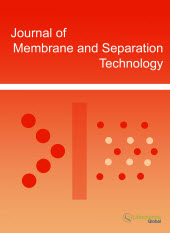jmst
Editor's Choice : Influence of a Microwave Irradiation on the Swelling and Permeation Properties of a Nafion Membrane
|
|
Abstract: The effect of a microwave irradiation at 2450 MHz on the swelling and permeation properties of a Nafion membrane in water and methanol media has been studied. The influence of the irradiation power and the exposure time has been analyzed. The results found show that the irradiation hardly affects the membrane liquid uptake, but it affects the expansion properties of the membrane. The hydraulic permeability coefficient of the unmodified and the irradiated membranes has been experimentally determined. Higher hydraulic permeability has been obtained for the irradiated membranes in both water and methanol, but the degree of increment in permeability coefficient with microwave depends on kinds of permeation liquid. The results have been discussed considering the degradation effect occurring on the membrane hydrophobic matrix, which affects to the membrane elastic properties. Keywords: Nafion membrane, microwave, hydraulic permeability, swelling, liquid uptake, water, methanol. Download Full Article |
Editor's Choice : High Hydrogen Permeance Silica Membranes Prepared by a Chemical Vapor Deposition Method
|
|
Abstract: H2 permselective silica hybrid membranes were successfully prepared by using a counter diffusion chemical vapor deposition (CVD) method. Hexyltrimethoxysilane (HTMOS), phenyltrimethoxysilane (PhTMOS) or diphenyldimethoxysilane (DPhDMOS) were used as silica precursors. The oxidants were O3 or O2. These reactants were provided at the opposite side of the γ-alumina substrates, and the deposition occurred in the pores of the substrates. The HTMOS/O3 derived membrane deposited at 450°C showed the highest H2 permselectivity. The H2 permeace was 2.1×10-6 mol m-2 s-1 Pa-1 with the H2/SF6 permeance ratio of 5.9×106. H2 permeances through the HTMOS derived membranes increased with increasing the deposition temperatures. While the H2 permeance through the PhTMOS and DPhDMOS derived membranes decreased with increasing the deposition temperatures. The PhTMOS derived membrane prepared at 150°C showed the H2 permeance of 1.7×10-6 mol m-2 s-1 Pa-1 with the H2/SF6 permeance ratio of 13. The PhTMOS membrane prepared at 320°C showed the highest H2/SF6 permeance ratio of 1.8×104among the PhTMOS derived membranes. However, the H2/SF6 permeance ratio through the DPhDMOS membranes showed the different trend. Higher H2/SF6 permeance ratio was found through the DPhDMOS derived membranes deposited at 180°C and 360°C. The maximum H2/SF6 permeance ratio was 4.2×104 through the DPhDMOS membrane deposited at 180°C. The decomposition properties of organic groups on silica surface are investigated by using hydrolysis powders derived from the each silica precursor. The HTMOS powders showed O3 stability after the high temperature treatment. Thus, high H2 permselective membranes were prepared by the HTMOS at 450 °C. Keywords: Silica hybrid membrane, counter diffusion CVD method, H2permselective membrane, pore size control, silica precursors. Download Full Article |
Editor's Choice : Ion Exchange Membranes for Electrodialysis: A Comprehensive Review of Recent Advances
|
|
Abstract: Electrodialysis related processes are effectively applied in desalination of sea and brackish water, waste water treatment, chemical process industry, and food and pharmaceutical industry. In this process, fundamental component is the ion exchange membrane (IEM), which allows the selective transport of ions. The evolvement of an IEM not only makes the process cleaner and energy-efficient but also recovers useful effluents that are now going to wastes. However ion-exchange membranes with better selectivity, less electrical resistance, good chemical, mechanical and thermal stability are appropriate for these processes. For the development of new IEMs, a lot of tactics have been applied in the last two decades. The intention of this paper is to briefly review synthetic aspects in the development of new ion-exchange membranes and their applications for electrodialysis related processes. Keywords: Electrodialysis, ion exchange membrane, anion exchange membrane, cation exchange membrane, bipolar membrane.Download Full Article |
Editor’s Choice : Investigation of Membrane-Based Total Heat Exchangers with Different Structures and Materials
|
|
Abstract: Membrane-based total heat exchangers are devices to recover both sensible heat and latent heat from the exhaust air. The performances of exchangers assembled with different structures and membranes vary dramatically. To investigate performances, five modules are fabricated for comparison. A test rig is built to measure the performance of these total heat exchangers. The heat and moisture transfer in the cores are studied simultaneously. These cores can be divided into two categories: with different structures and with different membranes. For the first category, parallel-plates, plate-fins and cross-corrugated structures are used. For the second category, three kinds of membranes, i.e. one-step hand-made CA membrane, hydrophobic-hydrophilic composite membrane and machine-made CA membrane are used. The heat and mass transfer coefficients, sensible cooling and latent effectiveness are obtained through experimental measurements. The experimental results show that the cross-corrugated ducts can enhance heat and mass transfer effectively. And the one-step hand-made CA membrane has the lowest resistance in heat and moisture transfer. Keywords: Total heat exchanger, core structure, membrane materials, energy recovery, comparison.Download Full Article |






















